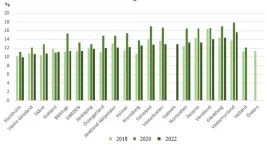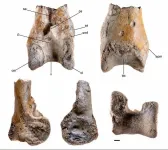(Press-News.org) CAMBRIDGE, MA – Silicon transistors, which are used to amplify and switch signals, are a critical component in most electronic devices, from smartphones to automobiles. But silicon semiconductor technology is held back by a fundamental physical limit that prevents transistors from operating below a certain voltage.
This limit, known as “Boltzmann tyranny,” hinders the energy efficiency of computers and other electronics, especially with the rapid development of artificial intelligence technologies that demand faster computation.
In an effort to overcome this fundamental limit of silicon, MIT researchers fabricated a different type of three-dimensional transistor using a unique set of ultrathin semiconductor materials.
Their devices, featuring vertical nanowires only a few nanometers wide, can deliver performance comparable to state-of-the-art silicon transistors while operating efficiently at much lower voltages than conventional devices.
“This is a technology with the potential to replace silicon, so you could use it with all the functions that silicon currently has, but with much better energy efficiency,” says Yanjie Shao, an MIT postdoc and lead author of a paper on the new transistors.
The transistors leverage quantum mechanical properties to simultaneously achieve low-voltage operation and high performance within an area of just a few square nanometers. Their extremely small size would enable more of these 3D transistors to be packed onto a computer chip, resulting in fast, powerful electronics that are also more energy-efficient.
“With conventional physics, there is only so far you can go. The work of Yanjie shows that we can do better than that, but we have to use different physics. There are many challenges yet to be overcome for this approach to be commercial in the future, but conceptually, it really is a breakthrough,” says senior author Jesús del Alamo, the Donner Professor of Engineering in the MIT Department of Electrical Engineering and Computer Science (EECS).
They are joined on the paper by Ju Li, the Tokyo Electric Power Company Professor in Nuclear Engineering and professor of materials science and engineering at MIT; EECS graduate student Hao Tang; MIT postdoc Baoming Wang; and professors Marco Pala and David Esseni of the University of Udine in Italy. The research appears in Nature Electronics.
Surpassing silicon
In electronic devices, silicon transistors often operate as switches. Applying a voltage to the transistor causes electrons to move over an energy barrier from one side to the other, switching the transistor from “off” to “on.” By switching, transistors represent binary digits to perform computation.
A transistor’s switching slope reflects the sharpness of the “off” to “on” transition. The steeper the slope, the less voltage is needed to turn on the transistor and the greater its energy efficiency.
But because of how electrons move across an energy barrier, Boltzmann tyranny requires a certain minimum voltage to switch the transistor at room temperature.
To overcome the physical limit of silicon, the MIT researchers used a different set of semiconductor materials — gallium antimonide and indium arsenide — and designed their devices to leverage a unique phenomenon in quantum mechanics called quantum tunneling.
Quantum tunneling is the ability of electrons to penetrate barriers. The researchers fabricated tunneling transistors, which leverage this property to encourage electrons to push through the energy barrier rather than going over it.
“Now, you can turn the device on and off very easily,” Shao says.
But while tunneling transistors can enable sharp switching slopes, they typically operate with low current, which hampers the performance of an electronic device. Higher current is necessary to create powerful transistor switches for demanding applications.
Fine-grained fabrication
Using tools at MIT.nano, MIT’s state-of-the-art facility for nanoscale research, the engineers were able to carefully control the 3D geometry of their transistors, creating vertical nanowire heterostructures with a diameter of only 6 nanometers. They believe these are the smallest 3D transistors reported to date.
Such precise engineering enabled them to achieve a sharp switching slope and high current simultaneously. This is possible because of a phenomenon called quantum confinement.
Quantum confinement occurs when an electron is confined to a space that is so small that it can’t move around. When this happens, the effective mass of the electron and the properties of the material change, enabling stronger tunneling of the electron through a barrier.
Because the transistors are so small, the researchers can engineer a very strong quantum confinement effect while also fabricating an extremely thin barrier.
“We have a lot of flexibility to design these material heterostructures so we can achieve a very thin tunneling barrier, which enables us to get very high current,” Shao says.
Precisely fabricating devices that were small enough to accomplish this was a major challenge.
“We are really into single-nanometer dimensions with this work. Very few groups in the world can make good transistors in that range. Yanjie is extraordinarily capable to craft such well-functioning transistors that are so extremely small,” says del Alamo.
When the researchers tested their devices, the sharpness of the switching slope was below the fundamental limit that can be achieved with conventional silicon transistors. Their devices also performed about 20 times better than similar tunneling transistors.
“This is the first time we have been able to achieve such sharp switching steepness with this design,” Shao adds.
The researchers are now striving to enhance their fabrication methods to make transistors more uniform across an entire chip. With such small devices, even a 1-nanometer variance can change the behavior of the electrons and affect device operation. They are also exploring vertical fin-shaped structures, in addition to vertical nanowire transistors, which could potentially improve the uniformity of devices on a chip.
###
This research is funded, in part, by Intel Corporation.
END
Nanoscale transistors could enable more efficient electronics
Researchers are leveraging quantum mechanical properties to overcome the limits of silicon semiconductor technology.
2024-11-04
ELSE PRESS RELEASES FROM THIS DATE:
UChicago scientist develops paradigm to predict behavior of atmospheric rivers
2024-11-04
When torrential rains and powerful winds hit densely populated coastal regions, whole cities can be destroyed—but governments and residents can take precautions with sufficient warning.
Many of these coastal deluges are caused by atmospheric rivers—regions of concentrated water vapor carried along on strong winds, sometimes called “rivers in the sky.” Meteorologists monitor them, but the ability to predict exactly how an atmospheric river might behave based on its underlying physics would offer more precise forecasts.
In a paper published today in Nature Communications, senior author Da Yang, assistant professor of geophysical sciences at the University ...
Childhood overweight is associated with socio-economic vulnerability
2024-11-04
More children have overweight in regions with high rates of single parenthood, low education levels, low income and high child poverty. The pandemic may also have reinforced this trend. This is shown by a study conducted by researchers at Uppsala University and Region Sörmland in collaboration with Region Skåne.
“During and after the pandemic, we see a greater difference between regions in terms of children's weight. It even looks like it has exacerbated health inequalities,” explains ...
Study reveals links between many pesticides and prostate cancer
2024-11-04
Researchers have identified 22 pesticides consistently associated with the incidence of prostate cancer in the United States, with four of the pesticides also linked with prostate cancer mortality. The findings are published by Wiley online in CANCER, a peer-reviewed journal of the American Cancer Society.
To assess county-level associations of 295 pesticides with prostate cancer across counties in the United States, investigators conducted an environment-wide association study, using a lag period between exposure and prostate cancer incidence of 10–18 years to account for the slow-growing nature of most prostate cancers. The years 1997–2001 ...
LiU researchers make AlphaFold predict very large proteins
2024-11-04
The AI tool AlphaFold has been improved so that it can now predict the shape of very large and complex protein structures. Linköping University researchers have also succeeded in integrating experimental data into the tool. The results, published in Nature Communications, are a step toward more efficient development of new proteins for, among other things, medical drugs.
In all living organisms, there is a huge variety of proteins that regulate cell functions. Basically, everything that happens in the body, from controlling muscles and forming hair to transporting ...
Fossil of huge terror bird offers new information about wildlife in South America 12 million years ago
2024-11-04
**EMBARGOED UNTIL RELEASE MONDAY, NOV. 4, AT 1 A.M. ET**
Researchers including a Johns Hopkins University evolutionary biologist report they have analyzed a fossil of an extinct giant meat-eating bird — which they say could be the largest known member of its kind — providing new information about animal life in northern South America millions of years ago.
The evidence lies in the leg bone of the terror bird described in new paper published Nov. 4 in Palaeontology. The study was led by Federico J. Degrange, a terror bird ...
Scientists create a world-first 3D cell model to help develop treatments for devastating lip injuries
2024-11-04
We use our lips to talk, eat, drink, and breathe; they signal our emotions, health, and aesthetic beauty. It takes a complex structure to perform so many roles, so lip problems can be hard to repair effectively. Basic research is essential to improving these treatments, but until now, models using lip cells — which perform differently to other skin cells — have not been available. In a new study published in Frontiers in Cell and Developmental Biology, scientists report the successful immortalization of donated lip cells, ...
One-third of patients with cancer visit EDs in months before diagnosis
2024-11-04
About 1 in 3 patients diagnosed with cancer in Ontario visited an emergency department (ED) in the 90 days before diagnosis, found a new study published in CMAJ (Canadian Medical Association Journal) https://www.cmaj.ca/lookup/doi/10.1503/cmaj.240952.
In a study that included more than 650 000 patients diagnosed with cancer between 2014 and 2021 in Ontario, 35% (229 683) had visited an ED in the 90 days before diagnosis. Among patients with ED visits before their cancer diagnosis, 64% had visited once, 23% had visited twice and 13% had 3 or more visits. ...
Adolescent exam anxiety can be intensified by pressure to achieve, says academic
2024-11-04
Former teacher Professor of Education David Putwain says ‘heavy-handed’ messages around test results can fuel extreme worry among some 16 to 18-year-olds, even when others respond well to such messages.
Putwain identifies several risk factors, for example students with certain personality traits, including those who are highly self-critical, can underachieve because of severe anxiety in exams. Certain demographics also report higher exam anxiety, including female persons and those from economically deprived backgrounds.
‘Temperature checks’ to identify at-risk ...
A digital health behavior intervention to prevent childhood obesity
2024-11-03
About The Study: A health literacy-informed digital intervention improved child weight-for-length trajectory across the first 24 months of life and reduced childhood obesity at 24 months. The intervention was effective in a racially and ethnically diverse population that included groups at elevated risk for childhood obesity.
Corresponding Author: To contact the corresponding author, William J. Heerman, MD, MPH, email Bill.Heerman@vumc.org.
To access the embargoed study: Visit our For The Media website at this link https://media.jamanetwork.com/
(doi:10.1001/jama.2024.22362)
Editor’s ...
Preventing obesity in very young children could be in the palm of parents’ hands
2024-11-03
A study co-led by a Johns Hopkins Children’s Center clinician-researcher shows that adding text messaging and other electronic feedback to traditional in-clinic health counseling for parents about feeding habits, playtime and exercise prevents very young children from developing obesity and potentially lifelong obesity-related problems.
Findings from the study, which was co-led by Eliana Perrin, M.D., M.P.H., Bloomberg Distinguished Professor of Primary Care at the Johns Hopkins University Schools of Medicine, Nursing and Public Health, will be published in JAMA and presented at the Obesity Society’s “Obesity Week” in San Antonio, both on Nov. ...
LAST 30 PRESS RELEASES:
NSF–DOE Vera C. Rubin Observatory spots record-breaking asteroid in pre-survey observations
Ribosomal engineering creates “super-probiotic” bacteria
This self-powered eye tracker harnesses energy from blinking and is as comfortable as everyday glasses
Adverse prenatal exposures linked to higher rates of mental health issues, brain changes in adolescents
Restoring mitochondria shows promise for treating chronic nerve pain
Nature study identifies a molecular switch that controls transitions between single-celled and multicellular forms
USU chemists' CRISPR discovery could lead to single diagnostic test for COVID, flu, RSV
Early hominins from Morocco reveal an African lineage near the root of Homo sapiens
Small chimps, big risks: What chimps show us about our own behavior
We finally know how the most common types of planets are created
Thirty-year risk of cardiovascular disease among healthy women according to clinical thresholds of lipoprotein(a)
Yoga for opioid withdrawal and autonomic regulation
Gene therapy ‘switch’ may offer non-addictive pain relief
Study shows your genes determine how fast your DNA mutates with age
Common brain parasite can infect your immune cells. Here's why that's probably OK
International experts connect infections and aging through cellular senescence
An AI–DFT integrated framework accelerates materials discovery and design
Twist to reshape, shift to transform: Bilayer structure enables multifunctional imaging
CUNY Graduate Center and its academic partners awarded more than $1M by Google.org to advance statewide AI education through the Empire AI consortium
Mount Sinai Health system receives $8.5 million NIH grant renewal to advance research on long-term outcomes in children with congenital heart disease
Researchers develop treatment for advanced prostate cancer that could eliminate severe side effects
Keck Medicine of USC names Christian Pass chief financial officer
Inflatable fabric robotic arm picks apples
MD Anderson and SOPHiA GENETICS announce strategic collaboration to accelerate AI-driven precision oncology
Oil residues can travel over 5,000 miles on ocean debris, study finds
Korea University researchers discover that cholesterol-lowering drug can overcome chemotherapy resistance in triple-negative breast cancer
Ushikuvirus: A newly discovered giant virus may offer clues to the origin of life
Boosting the cell’s own cleanup
Movement matters: Light activity led to better survival in diabetes, heart, kidney disease
Method developed to identify best treatment combinations for glioblastoma based on unique cellular targets
[Press-News.org] Nanoscale transistors could enable more efficient electronicsResearchers are leveraging quantum mechanical properties to overcome the limits of silicon semiconductor technology.


